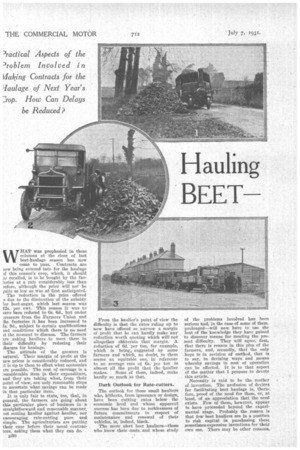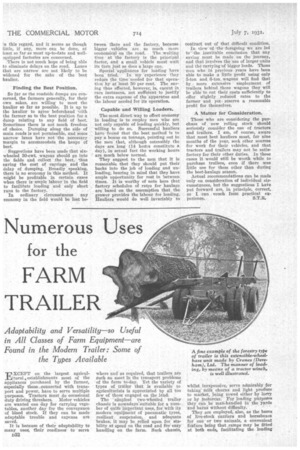Hauling BEET
Page 84

Page 85

Page 86

If you've noticed an error in this article please click here to report it so we can fix it.
WHAT was prophesied in these columns at the close of last beet-haulage season has now come to pass. Contracts are now being entered into for the haulage )f this season's crop, which, it should )z, recalled, is to be bought by the factories at a rate considerably less than iefore, although the pried will not be iuite so law as was at first anticipated. The reduction in the price offered a due to the diminution of the subsidy or beet-sugar, which last season was 12s. per cwt. This season it was to lave been reduced to 6s. 6d., but under, nessure from the Farmers Union and the factories it has been increased to Ts. 9d., subject to certain qualifications ind conditions which there is no need it the moment to discuss. The farmers ire asking hauliers to meet them in their difficulty by reducing their ffiarges for haulage.
The attitude of the growers is natural. Their margin of profit at the new prices is considerably reduced, and it is up to them to effect what economies are possible. The cost of carriage is a ...onsiderable item in their expenditure, and they are taking what, from their point of view, are only reasonable steps to ascertain what savings can be made in that particular item.
It is only fair to state, too, that, in general, the farmers are going about this particular piece of business in a straightforward and reasonable manner, not setting haulier against hardier, nor encouraging rate-cutting pure and simple. The agriculturists are putting their case before their usual contractors, asking them what they can do.
D30
From the haulier's point of view the difficulty is that the rates ruling up to now have offered so narrow a margin of profit that he can hardly make any reduction worth quoting which will not altogether obliterate that margin. A. reduction of 6d. per ton, for example, which is being,, suggested by some farmers and which, no doubt, to them seems an equitable one, in reference to an average rate of 6s. per ton is almost all the profit that the hardier makes. Some of them, indeed, make hardly so much as that..
Dark Outlook for Rate-cutters.
The outlook for those small hauliers who, hitherto, from ignorance or design, have been cutting rates below the economic level and whose apparent success has been due to recklessness of future commitments in respect • of maintenance and renewal of their vehicles, is, indeed, black.
The more alert beet hauliers—those who know their costs and whose study of the problems involved has been serious and, in the case of some of them, prolonged—will now have to use the best of the knowledge they have gained to discover means for meeting the present difficulty. They will agree, first, that there is reason in this plea of the farmers, and, secondly, that the only hope is in revision of method, that is to say, in devising . ways and means whereby savings in cost of operation can be effected. It is to that aspect of the matter that I propose to devote this article_ Necessity is said to be the mother of invention. The profusion of devices for facilitating beet haulage is, there-_ fore, proof of the need for them, or, at least, of an appreciation that the need exists. Few of them, however, appear to have proceeded beyond the experimental stage. Probably the reason is that few beet hauliers are in a position to risk capital in purchasing these sometimes expensive inventions for their own use. There may be other reasons, too, and probably the best way to discuss the matter is to start by considering the whole process from the harvesting of the crop to its delivery to the factory.
The beet is first pulled, topped and tailed by labourers, and it is part of their duty to knock the dirt oif the beet and lay it ready for easy collection. They work in groups of three, and each group can gather from five tons to 10 tons of beet per day, according to the conditions.
in normal icirennistancep the beet thus pulled is collected by horse-drawn tumbrils, each of which has a capacity for about 10 cwt., and taken to a dump at the side of the road, where it is piled in a heap until collected by motor lorries which deliver it to the factories. The bulk of beet grown in this country is transported in that way.
If the farm be very near the factory, say, a couple of miles away, it may be hauled direct, in which ease larger horse-drawn wagons are used and, some times if conditions be favourable, lorries of about 1-ton or 30-cwt. capacity are employed. Alternatively, if the factory , be much over 40 miles distant and if a railway station be within a &runic of miles from the farm, it may be taken direct from the farm to the goods siding.
The Haulier's Difficulties.
In normal circumstances the problem of the haulier begins at the dump ; it continues throughout the haul and to the factory, where itlis complicated somewhat by the unloading conditions. Each wagon load must be weighed, then unloaded, weighed again, and when, as often happens, there is congestion at the factory, this may involve three periods of waiting, one for each operation. .
Unloading may be effected in various ways. The quickest is that in which the beet is washed direct from the lorry into conduits leading it into the factory. 'Five minutes per 5:-ton. load is all the time needed for the operation.
Unfortunately, the amount of beet that can _be taken from the lorries in this manner is limited by the productive capacity of the factory and, because it is impossible to reconcile that with the rate of delivery, the rest of the beet must either be unloaded into silos, which arc deep, concrete-lined pits, or be placed in clamps All these methods involve the probability of delay in waiting a turn.
There may also be stoppages en route, partly because some portion of the journey must be along narrow lanes, not sufficient for one vehicle to pass another without risk of being bogged. That this risk is serious may he judged by the fact that the bogging of beet lorries is [Mite a comanon occurrence in
some parts of the country. Local hauliers who are accustomed to the work usually arrange for one-way traffic along these lanes, but they canrsYt, Of course, control the movements of other vehicles.
Difficulties of access to dumps and, when the farmer agrees to assist in loading, delays owing to the non-arrival of his proferred help, are further items which increase the cost of the work.
The most obvious way of cutting the cost of beet haulage would therefore appear to be to devise means for diminishing lost time from these various causes. Unfortunately, it does not appear that much can be done. Delays at the factory are not so great as they used to be. The provision of additional weighing facilities and better organization within the factory yard have contributed to an improved state of affairs this regard, and it seems as though little, if any, more can be done, at least so far as most up-to-date and wellquipped factories are concerned.
There is not much hope of being able to eliminate delays on the road. Lanes that are narrow are not likely to be widened for the sake of the beet haulier.
Finding the Best Position.
So far as the roadside dumps are concerned, the farmers generally, for their own sakes, are -willing to meet the haulier so far as possible. It is up to the haulier to agree beforehand with the farmer as to the best position for a dump relating to any field of beet. Sometimes there is not much freedom of choice. Dumping along the side of main roads is not permissible, and some narrow lanes have not the necessary margin to accommodate the heaps of beet.
Suggestions have been made that sixwheeled 30-cwt. wagons should go into the fields and collect the beet, thus saving the cost of carriage and the delay of dumping. Broadly speaking, there is no economy in this method. It might be profitable in certain cases when there is ample labour in the field to facilitate loading and only short runs to the factory.
In ordinary . circumstances any economy in the field would be lost be
tween there and the factory, because bigger vehicles are so much more economical on the road. The waiting time at the faCtory is the principal factor, and a small vehicle must wait its turn just as does a large one.
Special appliances for loading have
been ' tried. in my experience they retitle° the time needed for that operation by, at least 50 per cent. The saving thus effected, however, is, exceut in rare instances, not sufficient to justify the extra expense of the apparatus and the labour needed for its operation.
Capable and Willing Loaders.
The most direct way to effect economy in loading is to employ men who are not only capable of loading quickly, but willing to do so. Successful hauliers have found that the best method is to pay a bonus on tonnage, pointing out to the men that, although ostensibly the days are long (14 hours constitute a day), in actual fact the working hours are much below normal.
They suggest to the men that it is reasonable that they should put their backs into the job of loading and unloading, bearing in mind that they have ample opportunity for rest in between. times. It is worthy of note here that factory schedules of rates for haulage are based on the assumption that the grower provides the labour for loading. Hauliers would do well invariably to contract out of that difficult condition.
In view of -the foregoing we are led to the inevitable conclusion that any saving must be made on the journey, and that involves tbe use of larger units and the carrying'of bigger loads. Those men who in previous years have been able to make a little profit using only 5-ton and 6-ton wagons will find that by more extensive • employment of trailers behind those wagons they will be able to cut their costs sufficiently to offer slightly reduced rates to the farmer and yet reserve a reasonable profit for themselves.
A Matter for Consideration.
Those who are considering the purchase of new rolling stock should seriously consider the use of tractors and trailers. I am, of course, aware that most beet hauliers must, for nine months of the year, seek other sources for work for their vehicles, and that tractors and trailers may not be satisfactory for their other duties. In those cases it would still be worth while to purchase trailers, even if there was little use for them other than during the beet-haulage season.
Actual recommendations can be made only on consideration of individual circumstances, but the suggestions I hate put forward are, in principle, correct, as I can vouch from practical ex perience. S.T.R.




























































































































































